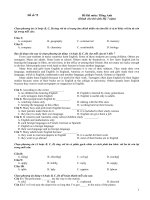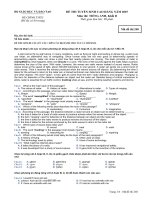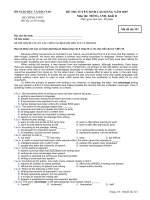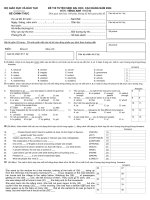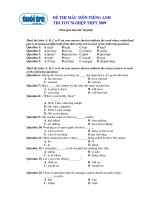Tài liệu Đề thi toán bằng tiếng anh 2009 pptx
Bạn đang xem bản rút gọn của tài liệu. Xem và tải ngay bản đầy đủ của tài liệu tại đây (108.77 KB, 16 trang )
HANOI MATHEMATICAL SOCIETY
======================
NGUYEN VAN MAU
HANOI OPEN MATHEMATICAL
OLYMPIAD
PROBLEMS AND SOLUTIONS
Hanoi, 2009
Contents
Questions of Hanoi Open Mathematical Olympiad 3
1.1 Hanoi Open Mathematical Olympiad 2006 . . . . . . . . 3
1.1.1 Junior Section, Sunday, 9 April 2006 . . . . . . . 3
1.1.2 Senior Section, Sunday, 9 April 2006 . . . . . . . 4
1.2 Hanoi Open Mathematical Olympiad 2007 . . . . . . . . 5
1.2.1 Junior Section, Sunday, 15 April 2007 . . . . . . 5
1.2.2 Senior Section, Sunday, 15 April 2007 . . . . . . 7
1.3 Hanoi Open Mathematical Olympiad 2008 . . . . . . . . 10
1.3.1 Junior Section, Sunday, 30 March 2008 . . . . . . 10
1.3.2 Senior Section, Sunday, 30 March 2008 . . . . . . 11
1.4 Hanoi Open Mathematical Olympiad 2009 . . . . . . . . 12
1.4.1 Junior Section, Sunday, 29 March 2009 . . . . . . 12
1.4.2 Senior Section, Sunday, 29 March 2009 . . . . . . 14
2
Questions of Hanoi Open
Mathematical Olympiad
1.1 Hanoi Open Mathematical Olympiad 2006
1.1.1 Junior Section, Sunday, 9 April 2006
Q1. What is the last two digits of the number
(11 + 12 + 13 + ··· + 2006)
2
?
Q2. Find the last two digits of the sum
2005
11
+ 2005
12
+ ··· + 2005
2006
.
Q3. Find the number of different positive integer triples (x, y, z) satis-
fying the equations
x
2
+ y − z = 100 and x + y
2
− z = 124.
Q4. Suppose x and y are two real numbers such that
x + y − xy = 155 and x
2
+ y
2
= 325.
Find the value of |x
3
− y
3
|.
Q5. Suppose n is a positive integer and 3 arbitrary numbers are choosen
from the set {1, 2, 3, . . . , 3n + 1} with their sum equal to 3n + 1.
What is the largest possible product of those 3 numbers?
3
1.1. Hanoi Open Mathematical Olympiad 2006 4
Q6. The figure ABCDEF is a regular hexagon. Find all points M
belonging to the hexagon such that
Area of triangle MAC = Area of triangle MCD.
Q7. On the circle (O) of radius 15cm are given 2 points A, B. The
altitude OH of the triangle OAB intersect (O) at C. What is AC if
AB = 16cm?
Q8. In ∆ABC, PQ//BC where P and Q are points on AB and AC
respectively. The lines PC and QB intersect at G. It is also given
EF//BC, where G ∈ EF , E ∈ AB and F ∈ AC with P Q = a and
EF = b. Find value of BC.
Q9. What is the smallest possible value of
x
2
+ y
2
− x − y − xy?
1.1.2 Senior Section, Sunday, 9 April 2006
Q1. What is the last three digits of the sum
11! + 12! + 13! + ··· + 2006!
Q2. Find the last three digits of the sum
2005
11
+ 2005
12
+ ··· + 2005
2006
.
Q3. Suppose that
a
log
b
c
+ b
log
c
a
= m.
Find the value of
c
log
b
a
+ a
log
c
b
?
Q4. Which is larger
2
√
2
, 2
1+
1
√
2
and 3.
1.2. Hanoi Open Mathematical Olympiad 2007 5
Q5. The figure ABCDEF is a regular hexagon. Find all points M
belonging to the hexagon such that
Area of triangle MAC = Area of triangle MCD.
Q6. On the circle of radius 30cm are given 2 points A, B with AB =
16cm and C is a midpoint of AB. What is the perpendicular distance
from C to the circle?
Q7. In ∆ABC, PQ//BC where P and Q are points on AB and AC
respectively. The lines PC and QB intersect at G. It is also given
EF//BC, where G ∈ EF , E ∈ AB and F ∈ AC with P Q = a and
EF = b. Find value of BC.
Q8. Find all polynomials P (x) such that
P (x) + P
1
x
= x +
1
x
, ∀x = 0.
Q9. Let x, y, z be real numbers such that x
2
+ y
2
+ z
2
= 1. Find the
largest possible value of
|x
3
+ y
3
+ z
3
− xyz|?
1.2 Hanoi Open Mathematical Olympiad 2007
1.2.1 Junior Section, Sunday, 15 April 2007
Q1. What is the last two digits of the number
(3 + 7 + 11 + ··· + 2007)
2
?
(A) 01; (B) 11; (C) 23; (D) 37; (E) None of the above.
Q2. What is largest positive integer n satisfying the following inequality:
1.2. Hanoi Open Mathematical Olympiad 2007 6
n
2006
< 7
2007
?
(A) 7; (B) 8; (C) 9; (D) 10; (E) 11.
Q3. Which of the following is a possible number of diagonals of a convex
polygon?
(A) 02; (B) 21; (C) 32; (D) 54; (E) 63.
Q4. Let m and n denote the number of digits in 2
2007
and 5
2007
when
expressed in base 10. What is the sum m + n?
(A) 2004; (B) 2005; (C) 2006; (D) 2007; (E) 2008.
Q5. Let be given an open interval (α; β) with β −α =
1
2007
. Determine
the
maximum number of irreducible fractions
a
b
in (α; β) with 1 ≤ b ≤
2007?
(A) 1002; (B) 1003; (C) 1004; (D) 1005; (E) 1006.
Q6. In triangle ABC, ∠BAC = 60
0
, ∠ACB = 90
0
and D is on BC. If
AD
bisects ∠BAC and CD = 3cm. Then DB is
(A) 3; (B) 4; (C) 5; (D) 6; (E) 7.
Q7. Nine points, no three of which lie on the same straight line, are
located
inside an equilateral triangle of side 4. Prove that some three of
these
points are vertices of a triangle whose area is not greater than
√
3.
Q8. Let a, b, c be positive integers. Prove that
(b + c − a)
2
(b + c)
2
+ a
2
+
(c + a − b)
2
(c + a)
2
+ b
2
+
(a + b − c)
2
(a + b)
2
+ c
2
≥
3
5
.
1.2. Hanoi Open Mathematical Olympiad 2007 7
Q9. A triangle is said to be the Heron triangle if it has integer sides and
integer area. In a Heron triangle, the sides a, b, c satisfy the equation
b = a(a −c). Prove that the triangle is isosceles.
Q10. Let a, b, c be positive real numbers such that
1
bc
+
1
ca
+
1
ab
≥ 1.
Prove
that
a
bc
+
b
ca
+
c
ab
≥ 1.
Q11. How many possible values are there for the sum a + b + c + d if
a, b, c, d
are positive integers and abcd = 2007.
Q12. Calculate the sum
5
2.7
+
5
7.12
+ ··· +
5
2002.2007
.
Q13. Let be given triangle ABC. Find all points M such that
area of ∆MAB= area of ∆MAC.
Q14. How many ordered pairs of integers (x, y) satisfy the equation
2x
2
+ y
2
+ xy = 2(x + y)?
Q15. Let p = abc be the 3-digit prime number. Prove that the equation
ax
2
+ bx + c = 0
has no rational roots.
1.2.2 Senior Section, Sunday, 15 April 2007
Q1. What is the last two digits of the number
11
2
+ 15
2
+ 19
2
+ ··· + 2007
2
2
?
1.2. Hanoi Open Mathematical Olympiad 2007 8
(A) 01; (B) 21; (C) 31; (D) 41; (E) None of the above.
Q2. Which is largest positive integer n satisfying the following inequal-
ity:
n
2007
> (2007)
n
.
(A) 1; (B) 2; (C) 3; (D) 4; (E) None of the above.
Q3. Find the number of different positive integer triples (x, y, z) satsfy-
ing
the equations
x + y − z = 1 and x
2
+ y
2
− z
2
= 1.
(A) 1; (B) 2; (C) 3; (D) 4; (E) None of the above.
Q4. List the numbers
√
2,
3
√
3, ,
4
√
4,
5
√
5 and
6
√
6 in order from greatest
to
least.
Q5. Suppose that A, B, C, D are points on a circle, AB is the diameter,
CD
is perpendicular to AB and meets AB at E, AB and CD are integers
and AE −EB =
√
3. Find AE?
Q6. Let P (x) = x
3
+ ax
2
+ bx + 1 and |P(x)| ≤ 1 for all x such that
|x| ≤ 1.
Prove that |a| + |b| ≤ 5.
Q7. Find all sequences of integers x
1
, x
2
, . . . , x
n
, . . . such that ij divides
x
i
+ x
j
for any two distinct positive integers i and j.
Q8. Let ABC be an equilateral triangle. For a point M inside ∆ABC,
let D, E, F be the feet of the perpendiculars from M onto BC, CA, AB,
respectively. Find the locus of all such points M for which ∠FDE
is a
1.2. Hanoi Open Mathematical Olympiad 2007 9
right angle.
Q9. Let a
1
, a
2
, . . . , a
2007
be real numbers such that
a
1
+a
2
+···+a
2007
≥ (2007)
2
and a
2
1
+a
2
2
+···+a
2
2007
≤ (2007)
3
−1.
Prove that a
k
∈ [2006; 2008] for all k ∈ {1, 2, . . . , 2007}.
Q10. What is the smallest possible value of
x
2
+ 2y
2
− x − 2y − xy?
Q11. Find all polynomials P (x) satisfying the equation
(2x − 1)P (x) = (x −1)P(2x), ∀x.
Q12. Calculate the sum
1
2.7.12
+
1
7.12.17
+ ··· +
1
1997.2002.2007
.
Q13. Let ABC be an acute-angle triangle with BC > CA. Let O, H
and F
be the circumcenter, orthocentre and the foot of its altitude CH,
respectively. Suppose that the perpendicular to OF at F meet the
side
CA at P . Prove ∠F HP = ∠BAC.
Q14. How many ordered pairs of integers (x, y) satisfy the equation
x
2
+ y
2
+ xy = 4(x + y)?
Q15. Let p = abcd be the 4-digit prime number. Prove that the equation
ax
3
+ bx
2
+ cx + d = 0
has no rational roots.
1.3. Hanoi Open Mathematical Olympiad 2008 10
1.3 Hanoi Open Mathematical Olympiad 2008
1.3.1 Junior Section, Sunday, 30 March 2008
Q1. How many integers from 1 to 2008 have the sum of their digits
divisible
by 5 ?
Q2. How many integers belong to (a, 2008a), where a (a > 0) is given.
Q3. Find the coefficient of x in the expansion of
(1 + x)(1 − 2x)(1 + 3x)(1 − 4x) ···(1 − 2008x).
Q4. Find all pairs (m, n) of positive integers such that
m
2
+ n
2
= 3(m + n).
Q5. Suppose x, y, z, t are real numbers such that
|x + y + z − t| 1
|y + z + t − x| 1
|z + t + x − y| 1
|t + x + y − z| 1
Prove that x
2
+ y
2
+ z
2
+ t
2
1.
Q6. Let P (x) be a polynomial such that
P (x
2
− 1) = x
4
− 3x
2
+ 3.
Find P (x
2
+ 1)?
Q7. The figure ABCDE is a convex pentagon. Find the sum
∠DAC + ∠EBD + ∠ACE + ∠BDA + ∠CEB?
Q8. The sides of a rhombus have length a and the area is S. What is
the length of the shorter diagonal?
1.3. Hanoi Open Mathematical Olympiad 2008 11
Q9. Let be given a right-angled triangle ABC with ∠A = 90
0
, AB = c,
AC = b. Let E ∈ AC and F ∈ AB such that ∠AEF = ∠ABC and
∠AF E = ∠ACB. Denote by P ∈ BC and Q ∈ BC such that EP ⊥ BC
and F Q ⊥ BC. Determine EP + EF + P Q?
Q10. Let a, b, c ∈ [1, 3] and satisfy the following conditions
max{a, b, c} 2, a + b + c = 5.
What is the smallest possible value of
a
2
+ b
2
+ c
2
?
1.3.2 Senior Section, Sunday, 30 March 2008
Q1. How many integers are there in (b, 2008b], where b (b > 0) is given.
Q2. Find all pairs (m, n) of positive integers such that
m
2
+ 2n
2
= 3(m + 2n).
Q3. Show that the equation
x
2
+ 8z = 3 + 2y
2
has no solutions of positive integers x, y and z.
Q4. Prove that there exists an infinite number of relatively prime pairs
(m, n) of positive integers such that the equation
x
3
− nx + mn = 0
has three distint integer roots.
Q5. Find all polynomials P (x) of degree 1 such that
max
a≤x≤b
P (x) − min
a≤x≤b
P (x) = b −a, ∀a, b ∈ R where a < b.
1.4. Hanoi Open Mathematical Olympiad 2009 12
Q6. Let a, b, c ∈ [1, 3] and satisfy the following conditions
max{a, b, c} 2, a + b + c = 5.
What is the smallest possible value of
a
2
+ b
2
+ c
2
?
Q7. Find all triples (a, b, c) of consecutive odd positive integers such
that a < b < c and a
2
+ b
2
+ c
2
is a four digit number with all digits
equal.
Q8. Consider a convex quadrilateral ABCD. Let O be the intersection
of AC and BD; M, N be the centroid of AOB and COD and P, Q be
orthocenter of BOC and DOA, respectively. Prove that MN ⊥ P Q.
Q9. Consider a triangle ABC. For every point M ∈ BC we difine
N ∈ CA and P ∈ AB such that AP MN is a parallelogram. Let O be
the intersection of BN and CP . Find M ∈ BC such that ∠P MO =
∠OMN.
Q10. Let be given a right-angled triangle ABC with ∠A = 90
0
, AB = c,
AC = b. Let E ∈ AC and F ∈ AB such that ∠AEF = ∠ABC and
∠AF E = ∠ACB. Denote by P ∈ BC and Q ∈ BC such that EP ⊥ BC
and F Q ⊥ BC. Determine EP + EF + F Q?
1.4 Hanoi Open Mathematical Olympiad 2009
1.4.1 Junior Section, Sunday, 29 March 2009
Q1. What is the last two digits of the number
1000.1001 + 1001.1002 + 1002.1003 + ··· + 2008.2009?
(A) 25; (B) 41; (C) 36; (D) 54; (E) None of the above.
1.4. Hanoi Open Mathematical Olympiad 2009 13
Q2. Which is largest positive integer n satisfying the inequality
1
1.2
+
1
2.3
+
1
3.4
+ ··· +
1
n(n + 1)
<
6
7
.
(A) 3; (B) 4; (C) 5; (D) 6; (E) None of the above.
Q3. How many positive integer roots of the inequality
−1 <
x − 1
x + 1
< 2
are there in (−10, 10).
(A) 15; (B) 16; (C) 17; (D) 18; (E) None of the above.
Q4. How many triples (a, b, c) where a, b, c ∈ {1, 2, 3, 4, 5, 6} and a <
b < c such that the number abc + (7 −a)(7 −b)(7 − c) is divisible by 7.
(A) 15; (B) 17; (C) 19; (D) 21; (E) None of the above.
Q5. Show that there is a natural number n such that the number a = n!
ends exacly in 2009 zeros.
Q6. Let a, b, c be positive integers with no common factor and satisfy
the conditions
1
a
+
1
b
=
1
c
.
Prove that a + b is a square.
Q7. Suppose that a = 2
b
+19, where b = 2
10n+1
. Prove that a is divisible
by 23 for any positive integer n.
Q8. Prove that m
7
− m is divisible by 42 for any positive integer m.
Q9. Suppose that 4 real numbers a, b, c, d satisfy the conditions
a
2
+ b
2
= c
2
+ d
2
= 4
ac + bd = 2
Find the set of all possible values the number M = ab + cd can take.
1.4. Hanoi Open Mathematical Olympiad 2009 14
Q10. Let a, b be positive integers such that a+b = 99. Find the smallest
and the greatest values of the following product P = ab.
Q11. Find all integers x, y such that x
2
+ y
2
= (2xy + 1)
2
.
Q12. Find all the pairs of the positive integers such that the product
of the numbers of any pair plus the half of one of the numbers plus one
third of the other number is three times less than 15.
Q13. Let be given ∆ABC with area (∆ABC) = 60cm
2
. Let R, S
lie in BC such that BR = RS = SC and P, Q be midpoints of AB
and AC, respectively. Suppose that P S intersects QR at T . Evaluate
area (∆P QT).
Q14. Let ABC be an acute-angled triangle with AB = 4 and CD be
the altitude through C with CD = 3. Find the distance between the
midpoints of AD and BC.
1.4.2 Senior Section, Sunday, 29 March 2009
Q1. What is the last two digits of the number
1000.1001 + 1001.1002 + 1002.1003 + ··· + 2008.2009?
(A) 25; (B) 41; (C) 36; (D) 54; (E) None of the above.
Q2. Which is largest positive integer n satisfying the inequality
1
1.2
+
1
2.3
+
1
3.4
+ ··· +
1
n(n + 1)
<
6
7
.
(A) 3; (B) 4; (C) 5; (D) 6; (E) None of the above.
Q3. How many integral roots of the inequality
−1 <
x − 1
x + 1
< 2
are there in (−10, 10).
1.4. Hanoi Open Mathematical Olympiad 2009 15
(A) 15; (B) 16; (C) 17; (D) 18; (E) None of the above.
Q4. How many triples (a, b, c) where a, b, c ∈ {1, 2, 3, 4, 5, 6} and a <
b < c such that the number abc + (7 −a)(7 −b)(7 − c) is divisible by 7.
(A) 15; (B) 17; (C) 19; (D) 21; (E) None of the above.
Q5. Suppose that a = 2
b
+19, where b = 2
10n+1
. Prove that a is divisible
by 23 for any positive integer n.
Q6. Determine all positive integral pairs (u, v) for which
5u
2
+ 6uv + 7v
2
= 2009.
Q7. Prove that for every positive integer n there exists a positive integer
m such that the last n digists in decimal representation of m
3
are equal
to 8.
Q8. Give an example of a triangle whose all sides and altitudes are
positive integers.
Q9. Given a triangle ABC with BC = 5, CA = 4, AB = 3 and the
points E, F, G lie on the sides BC, CA, AB, respectively, so that EF is
parallel to AB and area (∆EF G) = 1. Find the minimum value of the
perimeter of triangle EF G.
Q10. Find all integers x, y, z satisfying the system
x + y + z = 8
x
3
+ y
3
+ z
3
= 8
Q11. Let be given three positive numbers α, β and γ. Suppose that 4
real numbers a, b, c, d satisfy the conditions
a
2
+ b
2
= α
c
2
+ d
2
= β
ac + bd = γ
1.4. Hanoi Open Mathematical Olympiad 2009 16
Find the set of all possible values the number M = ab + cd can take.
Q12. Let a, b, c, d be positive integers such that a + b + c + d = 99. Find
the smallest and the greatest values of the following product P = abcd.
Q13.Given an acute-angled triangle ABC with area S, let points A
, B
, C
be located as follows: A
is the point where altitude from A on BC meets
the outwards facing semicirle drawn on BC as diameter. Points B
, C
are located similarly. Evaluate the sum
T = (area ∆BCA
)
2
+ (area ∆CAB
)
2
+ (area ∆ABC
)
2
.
Q14. Find all the pairs of the positive integers such that the product
of the numbers of any pair plus the half of one of the numbers plus one
third of the other number is 7 times less than 2009.



